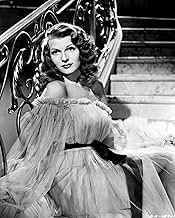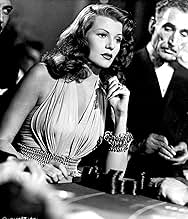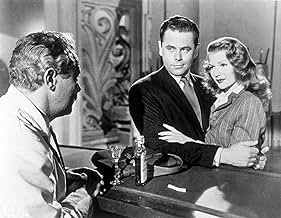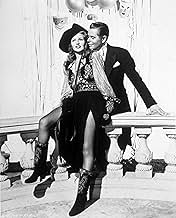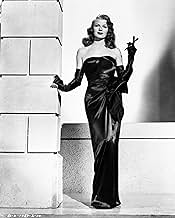CALIFICACIÓN DE IMDb
7.6/10
37 k
TU CALIFICACIÓN
Un jugador de poca monta contratado en un casino de Buenos Aires descubre que la nueva mujer de su jefe es su antigua amante.Un jugador de poca monta contratado en un casino de Buenos Aires descubre que la nueva mujer de su jefe es su antigua amante.Un jugador de poca monta contratado en un casino de Buenos Aires descubre que la nueva mujer de su jefe es su antigua amante.
- Dirección
- Guionistas
- Elenco
- Premios
- 4 premios ganados y 1 nominación en total
Mark Roberts
- Gabe Evans
- (as Robert Scott)
Donald Douglas
- Thomas Langford
- (as Don Douglas)
Julio Abadía
- Newsman
- (sin créditos)
- …
Enrique Acosta
- Gambler
- (sin créditos)
Ed Agresti
- Nightclub Patron
- (sin créditos)
Sam Appel
- Blackjack Dealer
- (sin créditos)
Nina Bara
- Girl at Carnival
- (sin créditos)
Edward Biby
- Gambler
- (sin créditos)
Robert Board
- American Cartel Member
- (sin créditos)
Opiniones destacadas
Johnny is a small time, but talented, hustler who finds himself at the wrong end of a gun on the dark back streets of Buenos Aires. He is rescued by a mysterious and controlling stranger, Ballin Mundson, who ends up being the owner of a club/casino that operates under the radar of the law. Johnny and Ballin form a close partnership with Johnny being the "man who runs the joint" and Ballin the Master. When Ballin takes a short leave and comes back married to the gorgeous Gilda, a threesome develops that puts a strain on the partnership. There is a burning mutual dislike between Johnny and Gilda. When Gilda feigns ignorance over not remembering his name, she coyly replies, "Johnny. So hard to remember . . . and so easy to forget." Of course there's much more to their acquaintance than they are willing to acknowledge, and a fusion of sexual heat, jealousy, fear and hatred keep the tension tightly wound which fuels the film. And of course there is Rita Hayworth up front and center. All the accolades that have been showered on her sexy "striptease" interpretation of "Put the Blame on Mame" are true! And still this film has much more to offer; an economical but effective story line; a tight witty script loaded with innuendo; and superb acting all around, especially the overlooked icy performance of George Macready as Ballin Mundson.
George Macready is playing the role that most people remember him for - Balin Munson, nightclub millionaire in Argentina, and a man with pure ice in his veins. He has two friends...Johnny (Glenn Ford), who Balin rescues from some toughs, and a slick, sharp little chum hidden in his walking stick - ever ready to cut up people that Balin doesn't like. He also has bigger plans. Men like Balin are not satisfied with successful nightclub/gambling casinos (however successfully they are run). During the Second World War several German and axis industrialists found Balin a comfortable man to do business with. It seems they were not sure if Der Fuhrer would win after all, so they transferred various papers concerning their international holdings in tungsten manufacturing to Balin for him to watch. Big mistake, for Balin realizes that the documents actually put these interests into his fully capable hands. And since he has managed to bribe a local tungsten manufacturer to sell out his plant in Argentina, if Balin can leave without police interference he can put together a cartel that will control the manufacture of such things as light bulb filaments. Sounds preposterous, but that is Balin's goal. He only has two problems: Johnny and Balin's beautiful wife Gilda (Rita Hayworth) apparently know each other and can't stand each other - but he has to leave them in charge of his nightclub while he's away. The other problem is Detective Maurice Obregon (Joseph Calleia) of the Argentine Police Department. Obregon suspects Balin's involvement in this illegal cartel scheme, and is watching him like a hawk.
"Gilda" is the film that made Rita Hayworth a star, and (with "Paths of Glory") gave Macready his justifiable claims to being one of Hollywood's best villains. Ironically many people don't think of Macready as anything but a villain in movies. It is true that in films like "Lady Without a Passport" and "The Big Clock" he was a villain, but he also could play decent people. He tries to help Spencer Tracy escape recapture and execution in "The Seventh Cross", and he is the wise minister and reformer who helps thwart Ray Milland (a.k.a. the Devil) in "Alias Nick Beal". But his Balin is pure, malevolent ice. There has been some suggestion that Balin's relationship with Johnny is actually a homosexual one (the business with the knife in the cane possibly being a metaphor for a male sex organ). Perhaps, but it is a weird friendship of two cynics who (briefly) enjoy each other's cynicism.
Curiously enough the business of the tungsten cartel is rarely discussed in going over the film. Like "Notorious" which came out about the same time, "Gilda" reminded American audiences of the large numbers of Nazis and collaborators who fled to South America in this period. In "Notorious" it was Brazil, and the gang (led by Alex Sebastian - Claude Rains) was fooling around with uranium. Here the idea of such people controlling a useful metal's manufacturing was not probed as much, probably because Balin was set to double cross them. But it is worrying to think of them coming so close to it.
In a discussion of the Warner Baxter film, "Such Men Are Dangerous" I mentioned that (like that film) there is a hint here of the 1928 mysterious death of millionaire Alfred Loewenstein, who managed to fall out of his private airplane over the English Channel. Here, to evade both the Nazis and Calleia, Balin arranges his plane to explode over the ocean (although the audience and Calleia see a figure parachute before it does so). Not quite the same problem as the Loewenstein mystery, but one can see the seed of the idea was there.
I would say this was certainly one of the better film noirs. It even was somewhat thought provoking.
"Gilda" is the film that made Rita Hayworth a star, and (with "Paths of Glory") gave Macready his justifiable claims to being one of Hollywood's best villains. Ironically many people don't think of Macready as anything but a villain in movies. It is true that in films like "Lady Without a Passport" and "The Big Clock" he was a villain, but he also could play decent people. He tries to help Spencer Tracy escape recapture and execution in "The Seventh Cross", and he is the wise minister and reformer who helps thwart Ray Milland (a.k.a. the Devil) in "Alias Nick Beal". But his Balin is pure, malevolent ice. There has been some suggestion that Balin's relationship with Johnny is actually a homosexual one (the business with the knife in the cane possibly being a metaphor for a male sex organ). Perhaps, but it is a weird friendship of two cynics who (briefly) enjoy each other's cynicism.
Curiously enough the business of the tungsten cartel is rarely discussed in going over the film. Like "Notorious" which came out about the same time, "Gilda" reminded American audiences of the large numbers of Nazis and collaborators who fled to South America in this period. In "Notorious" it was Brazil, and the gang (led by Alex Sebastian - Claude Rains) was fooling around with uranium. Here the idea of such people controlling a useful metal's manufacturing was not probed as much, probably because Balin was set to double cross them. But it is worrying to think of them coming so close to it.
In a discussion of the Warner Baxter film, "Such Men Are Dangerous" I mentioned that (like that film) there is a hint here of the 1928 mysterious death of millionaire Alfred Loewenstein, who managed to fall out of his private airplane over the English Channel. Here, to evade both the Nazis and Calleia, Balin arranges his plane to explode over the ocean (although the audience and Calleia see a figure parachute before it does so). Not quite the same problem as the Loewenstein mystery, but one can see the seed of the idea was there.
I would say this was certainly one of the better film noirs. It even was somewhat thought provoking.
And to think there used to be movies without graphic sex scenes that still got the point across, and how. The sexual tension between Ford and Hayworth in this movie is enough to make you run for the cold showers.
Hayworth is gorgeous and so is Ford. They are so good together and in this movie they are positively great. When great screen lovers are mentioned, I've often wondered why Ford and Hayworth aren't among them.
This is one of my absolute favorites.
Hayworth is gorgeous and so is Ford. They are so good together and in this movie they are positively great. When great screen lovers are mentioned, I've often wondered why Ford and Hayworth aren't among them.
This is one of my absolute favorites.
Gilda is directed by Charles Vidor. It sees Glenn Ford play a small time gambler Johnny Farrell. Who after cheating in a game of chance, finds himself with a gun in his back. This where George macready's Ballin Mundson comes into the picture. After fighting off the would be mugger they become friends. That is until Johnny gets caught trying his luck in another Casino. This time only to find out the casino belongs to Ballin, the two of them exchange ideas and Johnny agrees to work for him as the manager of his Casino. After a trip abroad Ballin comes back with a new wife. Johnny's Ex, Gilda played by the enigmatic Rita Hayworth.
The film is well made, and is shot in typical noir style. The story itself is fairly basic and offers no real surprises. The first half of the film is engrossing and builds up nicely, however the second half felt dull and bloated. The film would of been better off if it had twenty minutes cut out, the script would of felt a-lot tighter and better paced at ninety minutes.
The biggest strength of the film comes from the excellent performances. The three way dynamic between Johnny, Gilda and Ballin, is engrossing and fascinating to watch as the power struggle switches between the characters thought the duration of the film.
Over-all the films script was written well enough to keep me invested, and the ending makes up for the ponderous middle act. The performances are the main attraction of this film, especially the chemistry between Ford and Hayworth. The film isn't the best noir out there, but one that's still worth watching.
The film is well made, and is shot in typical noir style. The story itself is fairly basic and offers no real surprises. The first half of the film is engrossing and builds up nicely, however the second half felt dull and bloated. The film would of been better off if it had twenty minutes cut out, the script would of felt a-lot tighter and better paced at ninety minutes.
The biggest strength of the film comes from the excellent performances. The three way dynamic between Johnny, Gilda and Ballin, is engrossing and fascinating to watch as the power struggle switches between the characters thought the duration of the film.
Over-all the films script was written well enough to keep me invested, and the ending makes up for the ponderous middle act. The performances are the main attraction of this film, especially the chemistry between Ford and Hayworth. The film isn't the best noir out there, but one that's still worth watching.
Rita Hayworth positively sizzles as Gilda in this film-noir classic. From her initial hair-tossing scene to her near striptease while she sings "Put the Blame on Mame," Hayworth is captivating and more than convincing as the object of every man's desires. However, beyond the overtly heterosexual lures of Ms. Hayworth lurks a complex and ambiguous romantic triangle that provides more intrigue than the surface plot, which involves a gambling casino that is a front for shady operations that originated in a recently defeated, Fascist country.
Hayworth may either be the intruding wedge that comes between Glenn Ford and George Macready or the object of both men's romantic interests. From the initial meeting between Ford as two-bit gambler Johnny Farrell and Macready as Ballin Mundson the casino owner, an ambiguous, possibly homo-erotic, attraction is established between the two men. The lingering looks that they exchange can be read in several ways, but Bogie never looked into Cagney's eyes like Ford looks into Macready's. After Ford begins to work for Macready, his devoted care and slavish attention to his boss's needs exceed the bounds of employee and employer. When Hayworth moves into Macready's home as his new wife, Ford returns the key to the house as though he were a jilted lover. Ford's increasing jealousy becomes apparent after Hayworth's arrival on the scene, but it is unclear of whom he is jealous, Hayworth or Macready or possibly both. Perhaps Ford's character is as unsure of his own feelings as is the viewer, which makes the ambiguity even more intriguing. Macready's jealousy also grows as the heat between Ford and Hayworth intensifies, but, again, it is ambiguous of whom he is jealous.
With a dazzling performance by Hayworth, excellent black-and-white photography by Rudoph Mate, fine direction by Charles Vidor, and layers of psychological possibilities to ponder, "Gilda" is as golden as its title suggests.
Hayworth may either be the intruding wedge that comes between Glenn Ford and George Macready or the object of both men's romantic interests. From the initial meeting between Ford as two-bit gambler Johnny Farrell and Macready as Ballin Mundson the casino owner, an ambiguous, possibly homo-erotic, attraction is established between the two men. The lingering looks that they exchange can be read in several ways, but Bogie never looked into Cagney's eyes like Ford looks into Macready's. After Ford begins to work for Macready, his devoted care and slavish attention to his boss's needs exceed the bounds of employee and employer. When Hayworth moves into Macready's home as his new wife, Ford returns the key to the house as though he were a jilted lover. Ford's increasing jealousy becomes apparent after Hayworth's arrival on the scene, but it is unclear of whom he is jealous, Hayworth or Macready or possibly both. Perhaps Ford's character is as unsure of his own feelings as is the viewer, which makes the ambiguity even more intriguing. Macready's jealousy also grows as the heat between Ford and Hayworth intensifies, but, again, it is ambiguous of whom he is jealous.
With a dazzling performance by Hayworth, excellent black-and-white photography by Rudoph Mate, fine direction by Charles Vidor, and layers of psychological possibilities to ponder, "Gilda" is as golden as its title suggests.
¿Sabías que…?
- TriviaThere is a rumour that this film is the only time Rita Hayworth's real singing voice is heard, but that is not true. According to the bonus features from the DVD, Hayworth actually never recorded her own singing voice and was a talented lip-syncher. Anita Ellis dubbed almost all of her singing in this film. Hayworth always wanted to do her own singing, and Columbia Pictures chief Harry Cohn paid for her voice lessons, but she never developed a voice he considered strong enough to be used; Hayworth remained bitter about that for the rest of her life.
- ErroresWhen Farrell asks to cut the deck at the blackjack table, he shuffles the deck prior to the cut; this is not allowed.
- Citas
Gilda: You do hate me, don't you, Johnny?
Johnny Farrell: I don't think you have any idea of how much.
Gilda: Hate is a very exciting emotion. Haven't you noticed? Very exciting. I hate you too, Johnny. I hate you so much I think I'm going to die from it. Darling...
[they kiss passionately]
Gilda: I think I'm going to die from it.
- ConexionesEdited into Head (1968)
Selecciones populares
Inicia sesión para calificar y agrega a la lista de videos para obtener recomendaciones personalizadas
- How long is Gilda?Con tecnología de Alexa
Detalles
Taquilla
- Total a nivel mundial
- USD 5,999
- Tiempo de ejecución1 hora 50 minutos
- Color
- Relación de aspecto
- 1.37 : 1
Contribuir a esta página
Sugiere una edición o agrega el contenido que falta



